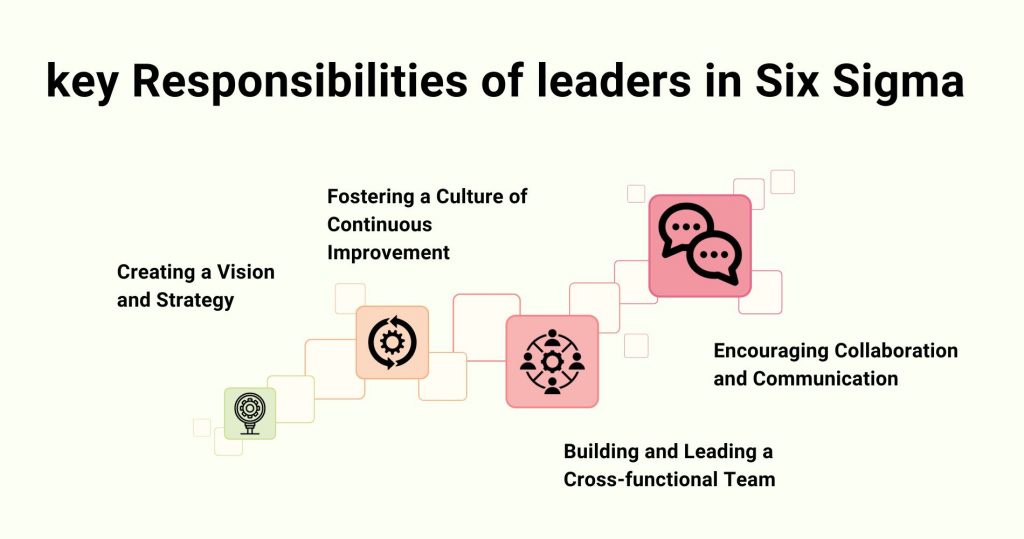
Six Sigma is a data-driven approach to process improvement widely adopted by organizations worldwide. With a focus on reducing defects, improving quality, and increasing efficiency, Six Sigma has helped organizations achieve significant results.
However, the success of a Six Sigma implementation depends not only on the tools and techniques used but also on the leadership driving the process. Leadership is crucial in setting the vision, direction, and strategy for Six Sigma, building and leading a cross-functional team, fostering a culture of continuous improvement, and encouraging collaboration and communication among team members.
In this blog, we will explore the role of leadership in Six Sigma, the key skills and practices required for success, and real-world examples of successful Six Sigma leadership. By understanding the importance of leadership in Six Sigma, organizations can improve their ability to drive results, achieve success, and realize the full potential of the Six Sigma approach.
So, let’s dive into the world of Six Sigma and see how leadership can play a critical role in its implementation and success.
What is Six Sigma and its Purpose?
Six Sigma is a methodology that works on a data-driven approach to process improvement that aims to reduce defects, improve quality, and increase efficiency in organizational processes. Motorola developed it in the 1980s, and organizations in various industries have widely adopted it.
Six Sigma aims to improve organizations’ performance and competitiveness by reducing the variability in their processes and ensuring that they deliver consistent results. It is achieved by using a structured, systematic, and data-driven approach to identify and eliminate sources of defects and variation in processes. Six Sigma is based on the DMAIC (Define, Measure, Analyze, Improve, Control) methodology, which provides a roadmap for continuous improvement.
In summary, Six Sigma aims to help organizations achieve better results by reducing defects, improving quality, and increasing efficiency in their processes, thus improving their performance and competitiveness.
How to Lead a Team? Team Leader Skills
Importance of Leadership in a Six Sigma Team
Leadership plays a critical role in the success of a Six Sigma implementation. Effective leadership not only provides direction and motivation but also fosters a culture of continuous improvement. Here are some of the key ways in which leadership is important in a Six Sigma team:
- Setting the vision and direction: Leaders need to clearly articulate the goals and objectives of the Six Sigma implementation, as well as the expected outcomes and benefits. This helps ensure everyone is aligned and working towards the same objectives.
- Building and leading a cross-functional team: Six Sigma teams typically consist of individuals from various departments, such as operations, engineering, and quality, who need to work together to achieve results. Leaders must bring together individuals with different backgrounds and perspectives, foster collaboration and communication, and ensure everyone is working towards the same goals.
- Fostering a culture of continuous improvement: Leaders play a key role in fostering a culture of continuous improvement within their organization. This involves promoting a positive attitude towards change, encouraging experimentation and innovation, and promoting a problem-solving mindset.
- Encouraging collaboration and communication: Effective communication is key to the success of any team, and Six Sigma teams are no exception. Leaders must encourage open and honest communication, foster collaboration and teamwork, and ensure that everyone works together to achieve common goals.
- Providing resources and support: Leaders need to provide the necessary resources and support to ensure that the Six Sigma implementation is successful. This includes providing adequate funding, allocating time and workforce, and providing training and development opportunities to team members
In short, leadership is a critical factor in the success of a Six Sigma implementation. By having essential skills, they can help organizations achieve better results, improve their performance and competitiveness, and realize the full potential of the Six Sigma approach.
Enroll in Invensis Learning’s Quality Management courses now & master Six Sigma leadership skills!
Key Leadership Skills for Six Sigma Success
It refers to the abilities and qualities crucial for leaders to lead a Six Sigma implementation effectively. The success of a Six Sigma project depends not only on the team’s technical skills and knowledge but also on the leader’s ability to provide guidance, direction, and motivation. Here are some key leadership skills for Six Sigma’s success:
- Visionary Leadership: Leaders must have a clear understanding of the goals and objectives of Six Sigma and be able to articulate a vision for its implementation. They must set achievable goals, align the team, and inspire others to work towards the same objectives
- Change Management: Leaders must be able to manage change and promote a positive attitude towards it effectively. They must communicate the benefits of change and help team members understand its impact.
- Problem-solving: Leaders must have strong problem-solving skills and be able to think critically and creatively. They must be able to analyze complex problems, identify root causes, and develop effective solutions.
- Communication: Leaders must have excellent communication skills and effectively communicate with team members, stakeholders, and customers. They must encourage open and honest communication within the team.
- Collaboration and Teamwork: Leaders must foster teamwork and bring together individuals with different backgrounds and perspectives.
- Emotional Intelligence: Leaders must have a high degree of emotional intelligence and be able to understand and respond to the emotions of others. This helps to build trust and foster a positive team dynamic.
- Adaptability: Leaders must be adaptable and be able to change their approach as needed to achieve goals and objectives. They must respond to new challenges, identify new opportunities, and be open to new ideas.
- Continuous Learning: Leaders must be committed to continuous learning, seeking to improve their skills and knowledge. They must be open to feedback, embrace new technologies and techniques, and be committed to continuous improvement.
By developing these key leadership skills, leaders can effectively guide and motivate their Six Sigma teams, drive projects toward successful completion, and achieve better results for their organizations.
Leadership’s Role in Six Sigma
The role of leadership in Six Sigma is crucial for the success of a Six Sigma project. Six Sigma is a data-driven, process-improvement method that aims to eliminate defects and improve organization quality. Therefore, the success of a Six Sigma project depends not only on the technical skills and knowledge of the team members but also on the leadership skills of the project leader. Here are some key responsibilities of leaders in Six Sigma:
Creating a Vision and Strategy
The leader’s role is to set a clear and achievable vision for implementing Six Sigma, communicate it effectively, and align the team toward its accomplishment. A successful Six Sigma implementation requires a well-defined strategy that outlines the goals and objectives of the project, the processes involved, and the timeline for completion. The leader must work with the team to identify the most important problems to solve and prioritize them based on their impact.
The leader must also clearly understand the organization’s culture, values, and processes and use this knowledge to build a strategy aligned with the organization’s goals and objectives. Finally, the leader must ensure that the strategy is flexible and adaptable, allowing the team to respond to new challenges and opportunities.
A key aspect of creating a vision and strategy is effective communication. The leader must articulate the vision in a way that inspires and motivates the team and clearly and concisely communicate the strategy. The leader must also be able to explain the benefits of Six Sigma and encourage team members to embrace the change.
Building and Leading a Cross-functional Team
In a Six Sigma project, it is crucial to have a diverse team that combines different areas of expertise and experience to solve complex problems and drive process improvement. The leader must work to bring together individuals from different departments, functions, and levels within the organization to form a high-performing team.
The leader must clearly understand each team member’s skills and experiences and use this knowledge to create a balanced and effective team. The leader must also be able to identify areas of potential conflict and work to resolve them, ensuring that the team can work together effectively.
Another important aspect of building and leading a cross-functional team is communication. The leader must effectively communicate the vision and strategy to the team and keep the team informed and engaged throughout the project.
The leader must also be able to facilitate discussions and encourage open and honest communication, creating a culture of trust and collaboration.
In addition, the leader must provide the team with the necessary resources and support, including training, coaching, and mentoring. The leader must also recognize and reward individual and team successes and provide opportunities for team members to grow and develop professionally.
Fostering a Culture of Continuous Improvement
Fostering a culture of continuous improvement is a crucial aspect of the leadership role in Six Sigma. Leaders play a critical role in promoting and supporting a culture that values continuous improvement and embraces change.
To foster a culture of continuous improvement, leaders must communicate the importance of Six Sigma and its goals to the entire organization. They must also ensure that the organization is aware of the benefits of Six Sigma and how it can drive positive change and growth.
Leaders must also model the behavior they expect from their teams and lead by example. This means they must be willing to embrace change and continuously look for ways to improve processes and procedures. They must also encourage and support their teams in their continuous improvement efforts.
In addition, leaders must provide their teams with the resources and support they need to succeed. This includes training, mentoring, coaching, and access to the latest tools and technology. Leaders must also recognize and reward individuals and teams for their successes, which helps to promote a culture of continuous improvement.
Encouraging Collaboration and Communication
Leaders must create an environment where individuals and teams can work together effectively to achieve common goals. To encourage collaboration and communication, leaders must first foster a culture of trust and respect. This means creating an environment where individuals feel comfortable sharing their thoughts and ideas and where constructive feedback is encouraged.
Leaders must also promote open and clear communication channels that allow for the free flow of information and ideas between individuals and teams. This includes regular team meetings, status updates, and progress reports that keep everyone informed and engaged.
In addition, leaders must ensure that their teams have the resources and support to work together effectively. This includes providing access to the latest tools and technology and creating cross-functional teams that bring together individuals with diverse skills and perspectives.
Leaders must also facilitate and encourage collaboration between different departments and teams within the organization. This can promote a more unified and cohesive approach to problem-solving and decision-making, leading to better results and greater success.
Finally, leaders must recognize and reward individuals and teams for their successes, which helps to promote a culture of collaboration and teamwork.
Real-world Examples of Successful Six Sigma Leadership
Following is an example of a successful implementation of Six Sigma leadership:
Case Study: Motorola
One of the Six Sigma examples that has successfully implemented the methodology with effective leadership is Motorola. Motorola was one of the early adopters of Six Sigma and had been using the methodology since 1986.
Motorola’s Six Sigma implementation was led by its CEO, Bob Galvin, who recognized the importance of continuous improvement in the company’s operations. As a result, he made Six Sigma a top priority for the company and provided the necessary resources and support to make it a success.
Under Galvin’s leadership, Motorola established a rigorous Six Sigma training program and implemented a system of metrics and performance evaluations to measure progress. The company also created cross-functional teams to identify and eliminate inefficiencies and improve processes.
One of the key aspects of Motorola’s Six Sigma implementation was its focus on leadership and employee empowerment. The company encouraged employees at all levels to participate in Six Sigma projects and provided them with the training and support they needed to succeed.
The results of Motorola’s Six Sigma implementation were impressive. The company improved its quality, reduced costs, and increased customer satisfaction. The program also helped to foster a culture of continuous improvement and innovation, which has helped the company to remain competitive in the rapidly changing technology industry.
In conclusion, Motorola’s successful implementation of Six Sigma is a testament to the importance of effective leadership in driving continuous improvement. The company achieved significant results by prioritizing Six Sigma, providing the necessary resources and support, and empowering employees at all levels. As a result, it maintained its position as a leader in the technology industry.
Conclusion
In conclusion, the role of leadership in a Six Sigma team is critical to its success. Effective leaders in Six Sigma teams possess key skills such as vision and strategy development, team building, change management, and communication.
In addition, a good leader in a Six Sigma team provides direction and support and empowers team members to take ownership of their work and continuously improve processes. By providing the right resources, training, and support, leaders can help their Six Sigma teams achieve significant results, improve quality, reduce costs, and increase customer satisfaction.
The Motorola case demonstrates leadership’s effective impact on a Six Sigma implementation. Therefore, companies looking to implement Six Sigma should focus on developing their leaders and empowering them to drive change and continuous improvement within their organizations.
Looking to embrace Continuous Improvement with Six Sigma Certification? If so, sign up with Invensis Learning and start your learning today! Six Sigma certification can enhance career prospects, increase earning potential, and improve organizational performance, resulting in higher quality and customer satisfaction.















